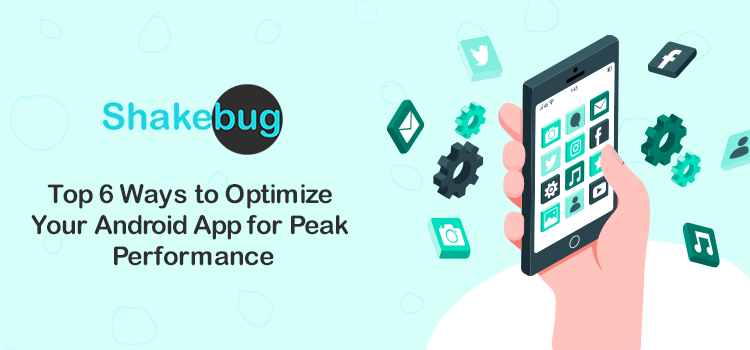There’s an ongoing debate in the app development community about which platform offers the best mobile user experience, but it’s clear that Android users are engaged. One of the most important factors contributing to this engagement is your Android app’s performance.
You can ensure that you stay at the top of your customers’ minds by optimizing your app for peak performance.
Here are 6 top ways you can optimize your Android app so it’s running at peak performance. These tips will help increase your app’s conversion rates and in-app retention, which ultimately leads to increased revenue and customer satisfaction!
1. Keep your app up to date
Keeping your app up to date will ensure that you’re providing your users with the best experience possible. It’ll also make sure that your app is compatible with new versions of the operating system, which provides a higher level of security and stability.
New features are released regularly, so be sure to update your app at least every six months to a year. Make sure you test it on both older versions of the OS as well as newer ones to avoid any compatibility issues or bugs in this ever-evolving environment. This can be easily achieved if you know the ways to increase the productivity of developers.
2. Use high-quality images
Image quality is important because the higher the resolution, the more detailed an image will be. Plus, many people look at images on their smartphones, so it’s crucial that your images are high-quality and optimized for viewing on small screens.
There are several ways you can optimize your app’s graphics to increase performance:
- Use a minimalistic design
- Decrease file size
- Use low-res graphics when necessary
- Resize images with a crop tool
3 . Minimize your app’s size
One of the best ways to make your app more responsive is by minimizing its size. If your app takes up too many system resources, it can slow down your device’s performance and cause you to have a bad experience with your app. Therefore, you must create an app that only includes the necessary features. You should also optimize any graphics and videos used in your app. Minimize these as much as possible without sacrificing quality. By these, you will be able to minimize your app size which will result in faster loading times and increase user satisfaction levels.
4. Use the latest features
It’s not enough to just do what the competition is doing; you need a competitive edge. This can be achieved in many ways, but one way is by using the latest features of your app. These are features that are currently only available on your app and nowhere else. By incorporating the new features, you can increase the performance of your app and make it more attractive to users.
5. Test your app thoroughly
It’s essential that you thoroughly test your app before releasing it, especially if you have a product with multiple features and interfaces. You need to make sure that you’ve considered all of the different ways users could interact with your app, which may require some unconventional user testing methods like usability testing in mobile app development, watching people in natural environments or creating a live prototype and asking testers what they think.
If possible, always include beta testers on your team who can provide an external perspective. When you find out about an issue during this process, you’ll know how to fix it before the real thing happens.
6. App launch time
Launch or on time delivery of mobile apps is a crucial metric for the performance of your app. Poor launch times can ruin the user experience and cause people to switch between different apps. If you haven’t already, it’s time to optimize your app launch time so that you are delivering a top-notch user experience.
The following five optimizations will help you achieve this goal:
- Code less – The more code that is loaded when launching the app, the longer it will take for an app to load.
- Group resources – When loading resources such as images, videos or fonts, the browser starts loading them all in parallel before deciding which ones to use.
- Reduce startup size -focus on making sure only what is necessary at startup is downloaded.
- Use lazy loading – With lazy loading enabled, only items necessary at launch are downloaded rather than downloading everything and not using most of it.
- Update dependencies – Updates will often fix bugs or include new features which may improve performance.
If you are a little bit confused with the terms included in optimization you can go through the mobile app terminology to get familiar with it.
7. Network performance
There are a lot of things that can affect your app’s performance, but one of the most important considerations is your network performance. To reach the broadest possible audience, you’ll need to optimize your app’s performance on different networks.
Here are three ways you can optimize your app’s network performance-
- Consider using an offline mode in which some features of the app aren’t available until they’re reconnected to a connection.
- Test against as many networks and connections as possible before release to ensure that it performs optimally on every device type.
- Ensure that images and videos have a very low compression rate so that they don’t take up much bandwidth or load time when downloading them.
8. Memory use
Memory is the most important resource on your smartphone, and it’s the one that is always in the shortest supply. No matter what type of app you’re building, you need to be mindful of how much memory it consumes.
Keeping an eye on memory usage is one of the most important things you can do to keep your app running smoothly.
9. Avoid memory leaks
Memory leaks are one of the most common performance killers in Android, but luckily they’re also one of the easiest problems to fix. Memory leaks occur when an app allocates memory from a device’s RAM and then never releases it, leading to slower performance and increased battery use over time.
To avoid memory leaks in your app, keep these five things in mind:
- Remove or update any third-party libraries with known memory leak issues.
- Make sure your activity isn’t leaking memory.
- Monitor how much memory is being used by each process using Activity Manager.
- Follow Google’s best practices for release builds.
- Use OkHttp library instead of HttpURLConnection.
10. Avoid Out Of Memory (OOM) errors
Many strategies can optimize your app’s performance, but the most important is to avoid Out Of Memory (OOM) errors. OOM errors occur when your app runs out of memory. These errors can slow down your app and make it crash.
To avoid these errors, you need to free up space on the device by removing any unused files or data from the device and using less memory by optimizing your application’s code.
Conclusion
There are many ways that you can optimize your app for peak performance. The best thing you can do is follow some of these key strategies and make sure your app is working at its absolute best.


